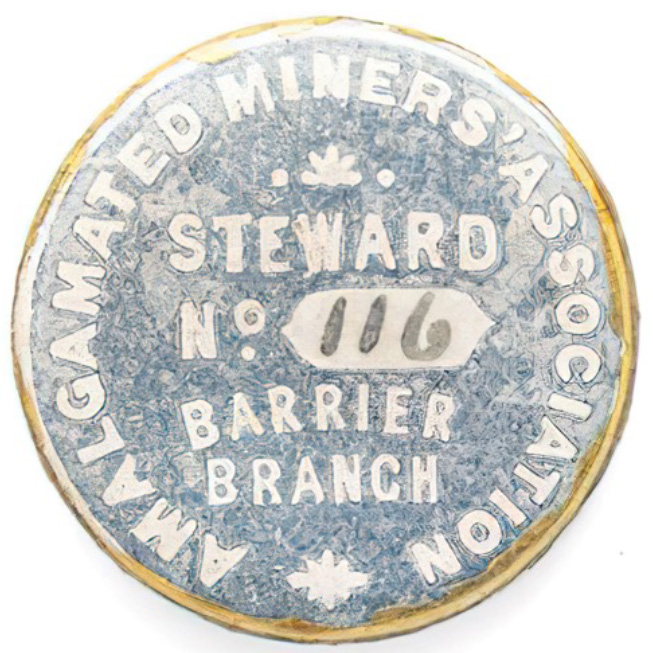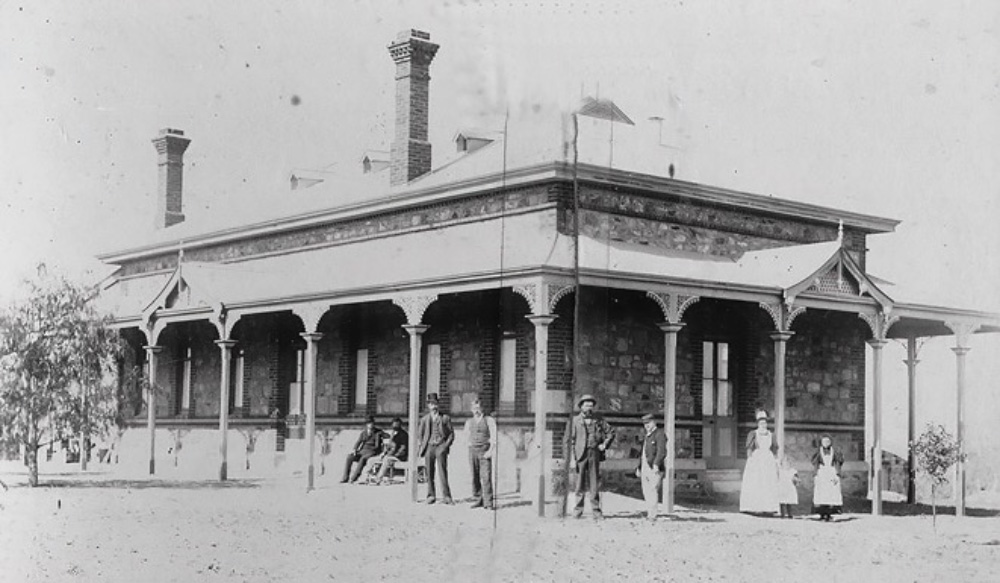The story of Broken Hill begins with the search for water. The Bulalli, Barkinji and Wilyakali river people, wandered the arid lands of what colonials later called Far Western New South Wales in search of food and water. Some tribes held ceremony and painted rock art in watering places such as Muttawintjie. They knew the location of soaks and creeks that to the naked European eye were merely hollows and stony beds. From 1850, the Darling River (Barka) supported Squatter’s cattle and sheep. Drovers kept moving west in search of new pasture and water. Bullock teams supplying the outstations and carting wool to and from South Australia, watered at the Thackaringa Dam. Unsurprisingly, the discovery of minerals was made by two well sinkers, Nickel and McLean. They plonked a lump of Galena on the bar of John Stokie’s grog shanty and he identified the first specimen of Silver-Lead ore on the Barrier Ranges. Another publican, Paddy Green of Menindee, pegged the claim as the Pioneer Mine in 18761.
Three years later, John Stokie meandered on in his quest for water and beer, and established the Umberumberka store, advertising wine and spirit discounts for station hawkers. It was situated on flat land beside a shady creek the first nations people referred to as a native rat hole. In 1881, Stokie discovered silver and pegged his claim. The Umberumberka Mine gave rise to the first settlement of a store, a hotel and two boarding houses for miners. As the silver flowed more families settled and Silverton was incorporated as a municipality. Market gardens sprang up along the creek and supplied vegetables and dairy produce to the new field at the black ironstone outcrop described as ‘the broken hill’. It had been discovered by a German boundary rider, Charles Rasp, from Mount Gipps Station. The Silverton Tramway Company built a rail line to Cockburn on the South Australian Border and serviced many mining settlements of one to five hundred souls at Thackaringa, The Pinnacles, the Apollyon Valley, Nickelville, Albion Town, Taltingan on Round Hill, Mount Robe, Tarrawingee, Eurowie, Eaglehawk and Acacia Dam.
A German community formed around Carltown , named after the German sly-grog pervayor German Charlie Carl. The more respectable brewers were the Resch brothers, Richard, Emil and Edmund, founders of the Lion Brewery. They were in business with the Mayor, John Penrose, an irrascible Yorkshire sailor who had come ashore in Sydney and followed the Rivers to Wilcannia where he set up as a publican and married Caroline Mitselberg. The couple then moved to the bonanza that was Silverton. They had eight daughters and John Penrose became the Mayor of Silverton. In 1884, a public meeting in Silverton formed the Barrier Miner’s Association a friendly society of the English model for the relief of miners who suffered injury.
When fever came along and encamped upon the field for a spell, men lay down like wounded sheep to die, with no mother’s hand to soothe them, no sisters love to relieve their sufferings, and in many cases deserted by their mates.
A.G.Hales, Wanderings of a Simple Child, 1890
The following year, a group of pastoral workers and local mineral speculators formed a syndicate called the Broken Hill Propriety Company Limited. The astounding value of their blocks elevated the hammer-and-tap dugouts to an industrial level of production.

In January 1886, it was Big Jim Wilkinson, the Canadian Coach driver and mineral speculator, who presided over a public meeting to form a more radical union. The Amalgamated Miners’ Association of Australasia was formed on a Victorian model of agitation for miner’s rights and they adopted the motto, ‘United We Stand, divided we fall’. Meetings were held that week across the diggings at Silverton, Day Dream, Purnamoota and Broken Hill. Their eleven point agenda, including fair wages, compensation for injury, an eight hour day and a weekly recreation day, would take thirty four years of struggle to achieve.

Culture thrived in Silverton on the strength of the silver slug: banks, a two storey De Baun’s Hotel; coach services, teamsters, miners, a hospital, four churches, Kidman’s Butcher shop, Dickens’ Pastoral Agency, municipal chambers, a literary society, brass band, school and the Silver Age newspaper. The first policeman, Richard O’Connell, fresh from the trail of Ned Kelly at Jerilderie, raised hell as the local policeman and retired to the genteel life of a publican.

The shady creeks at Umberumberka and at Stephen’s Creek became recreation grounds for the population of miners, townsfolk and their families. The mines at Broken Hill, with sulphurous smelters and greedy wood-fired engines, soon denuded the surrounding country of trees. The dustbowl was blighted by water famine and drought. The green and shady Penrose Park and McCullum Park, were serviced by the Silverton Tramway Company which delivered day-trip passengers to Silverton and Tarrawingie.
While the Penrose family home was being jinkered to Chapel Street, to serve as a Salvation Army home for unmarried mothers, the Resch Brothers moved to Melbourne, Sydney and Cootamundra. They established and grew the Lion, Resch and Carlton breweries in these cities. Mr Shelley, the Broken Hill cordial maker, also successfully exported his business to Sydney. The temperance movement, fostered by the high number of Cornish and Methodist residents, preferred cordials to beer. All were in need of a supply of fresh water.

There are many photographs of Victorian ladies and their dapper beaus enjoying a bottle of cordial under a gum tree. Two invisible things were necessary for a picnic, leisure and wages. These formed the core of the miner’s demands and prompted their first refusal to work that occurred in 1889. They wanted a reduction in working hours and an increase in wages. The withholding of the only resource available to the workers, labour, would only work if their fellows agreed to stop work also. They had to be unified in their demands and sanctions. Or this reason, the non-unionist or ‘blackleg’ became the scourge of their lives. Solidarity was the only means of exerting power over the Mining Company. The Silver had taken thousands of years to form beneath the earth, but once above ground it generated the Silver speculators who multiplied like tin-pot regents. Forty Five Million pounds worth of minerals were extracted from the Broken Hill mines between 1883 and 1900. It was the largest deposit of Silver ore discovered in the world. Stone mansions sprang up in Adelaide and Melbourne on the back of that wealth, yet in the town of Broken Hill,
In our midst there are many families of hard working people who know not how to make both ends meet and the children of course suffer, and I have seen some youngsters about our mining field whose wretched clothing and dirty skin would rival the meanest and most unclean of London.
A.G. Hales, 1890
- Kearns, RHB (1980) Silverton – A brief history,Thebarton: Broken Hill Historical Society, p.6
